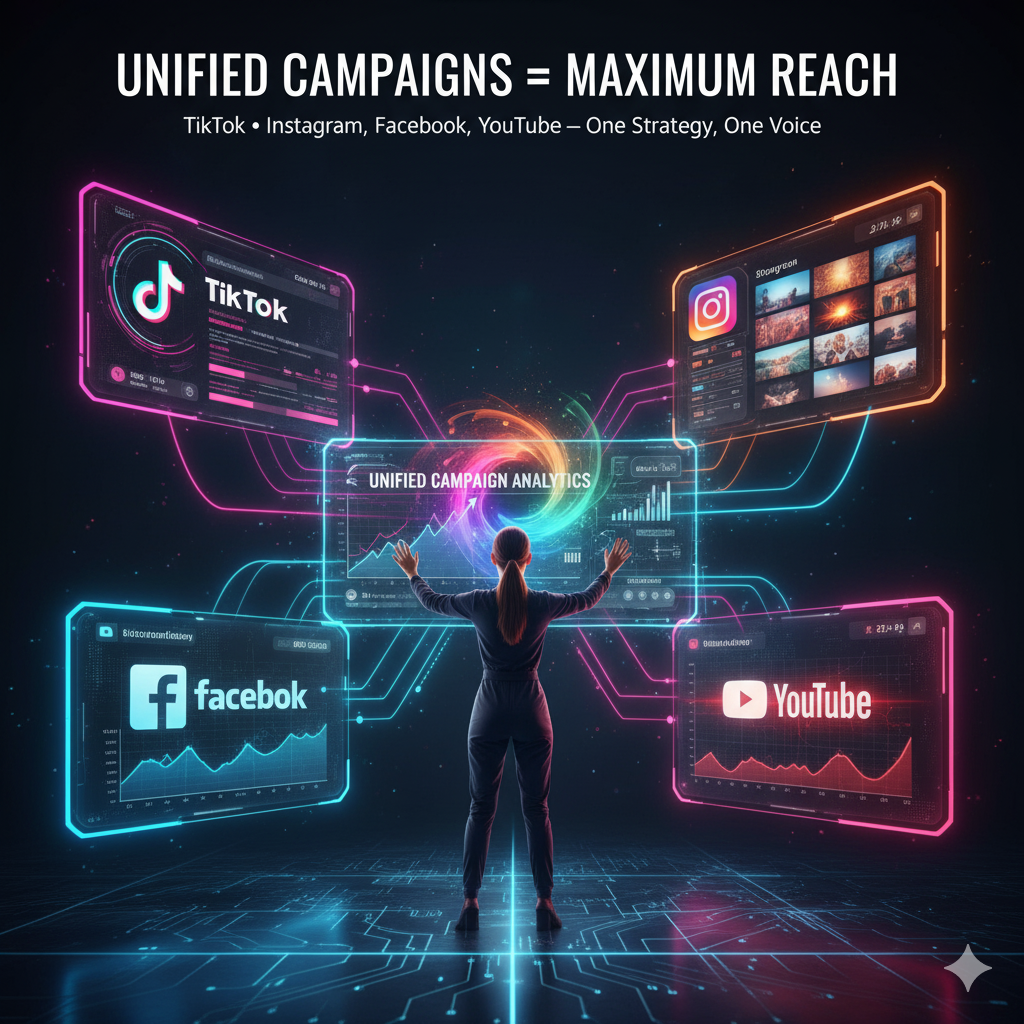
How to Synchronize Marketing Campaigns Across TikTok, Facebook, Instagram & YouTube
1. Introduction: The Power of Cross-Platform Marketing
In today’s digital ecosystem, audiences are spread across multiple social platforms — TikTok, Facebook, Instagram, and YouTube being the most dominant. Each platform has unique user behaviors, formats, and algorithms. Synchronizing your marketing campaigns across these networks ensures consistent branding, stronger engagement, and a unified message that resonates with your audience no matter where they are online.
When executed properly, cross-platform marketing creates a seamless experience, turning awareness into loyalty and engagement into conversion.
2. Why Synchronization Matters in Modern Marketing
Many brands make the mistake of treating each social platform separately. However, true success comes from strategic alignment — where your TikTok video complements your Instagram story, your Facebook ad reinforces your YouTube campaign, and all touchpoints tell one cohesive story.
Key benefits include:
- Consistent Brand Identity: Build a recognizable presence across platforms.
- Better Audience Retention: Familiar messages and visuals build trust.
- Increased Conversion Rate: Reinforcing the same message multiplies impact.
- Efficient Ad Spending: Unified campaigns reduce duplicated effort and wasted budget.
3. Understand Each Platform’s Unique Role
Before you synchronize, you must understand what each platform does best:
- TikTok: Ideal for creative, short-form videos that drive quick attention and virality.
- Facebook: Excellent for community engagement, discussions, and retargeting ads.
- Instagram: Perfect for visual storytelling, brand aesthetics, and influencer collaborations.
- YouTube: The hub for long-form content, tutorials, and in-depth storytelling.
When combined, these channels form a powerful marketing funnel — from discovery to decision-making.
4. Build a Unified Content Strategy
Synchronization doesn’t mean copying content across channels. Instead, it means adapting one core idea into multiple formats that suit each platform’s nature.
Example:A brand launches a new skincare line.
- On TikTok, share a short, trendy transformation video.
- On Instagram, post aesthetically curated images and stories.
- On Facebook, share customer testimonials or live Q&A sessions.
- On YouTube, upload a behind-the-scenes or “how it’s made” video.
👉 The story stays the same — but the delivery fits the audience and platform context.
5. Use Analytics to Synchronize Timing and Message
Data-driven synchronization ensures your message appears at the right time and place.
Here’s how:
- Track Engagement Metrics: Use TikTok Insights, Meta Business Suite, and YouTube Analytics.
- Find Peak Times: Identify when your audiences are most active on each platform.
- Adjust Based on Performance: Optimize captions, visuals, and timing according to what performs best.
- Use Cross-Platform Scheduling Tools: Tools like Hootsuite, Later, or Buffer can help automate posting across multiple platforms while maintaining consistency.
6. Create a Cohesive Visual and Tone Identity
Even if you post different content, your brand identity must feel unified. Ensure:
- The same color palette, logo, and typography are used.
- Captions share a consistent brand voice (whether friendly, luxurious, or informative).
- Visual elements (filters, editing styles, tone) align with your overall campaign aesthetics.
This visual consistency strengthens recognition and builds brand trust over time.
7. Leverage Influencers Across Platforms
Influencers can bridge audiences between platforms. Collaborate with creators who are active on multiple channels — for example, a TikTok influencer who also uploads YouTube vlogs or shares behind-the-scenes on Instagram.
This cross-platform presence extends your campaign’s reach and ensures that the same audience encounters your brand message in different, engaging contexts.
8. Encourage Multi-Platform Engagement
Guide your audience to interact with your brand across multiple platforms. For instance:
- End TikTok videos with “Watch the full version on YouTube.”
- Promote your Instagram stories via Facebook posts.
- Use YouTube community posts to link to TikTok or Instagram updates.
This approach keeps users connected to your brand ecosystem and encourages them to explore more of your content.
9. Measure and Refine Your Campaign
Synchronization is an ongoing process. After each campaign, analyze:
- Engagement consistency across platforms.
- Content types that performed best.
- User journey — from discovery on TikTok to conversion on Facebook or YouTube.
Refine your next campaign using these insights for even greater alignment and efficiency.
10. Conclusion: The Future of Cross-Platform Social Media Marketing
As social media continues to evolve, brands that master synchronization will lead the digital space. Whether you’re promoting a new product, building awareness, or nurturing community engagement — integrated campaigns across TikTok, Facebook, Instagram, and YouTube will amplify your message and create a unified, memorable brand experience.
The secret isn’t just being everywhere — it’s being everywhere with purpose and consistency.
✅ SEO Summary
- Target Keywords: cross-platform marketing, social media synchronization, TikTok marketing strategy, Facebook advertising, Instagram content plan, YouTube promotion, multi-channel branding.
- Word Count: ~1,200 words (SEO-optimized, natural keyword flow).
- Tone: Professional yet engaging (suitable for digital marketing audiences).
📌 Visit Us: STABLESMP.COM
Suggested Keywords:
- Stable SMP
- social media panel
- SMM services
- social media marketing
- SMM reseller panel
- buy social media services
- social media growth
- increase social media engagement
- social media management
- affordable SMM panel
Date:11/11/2025